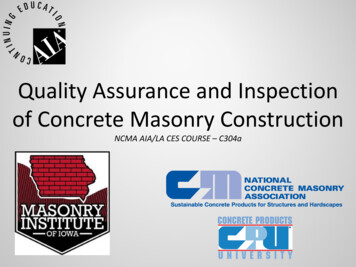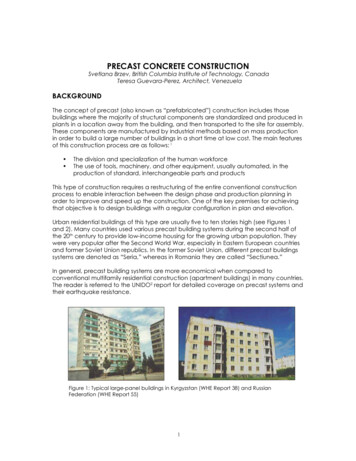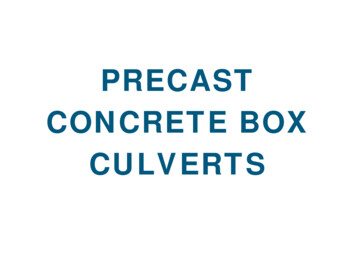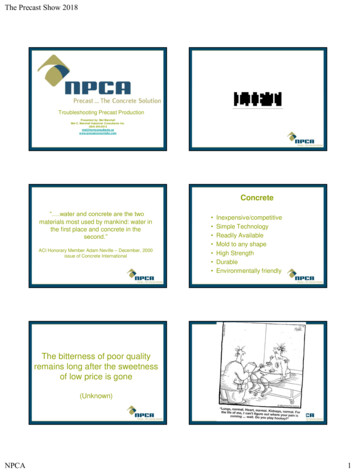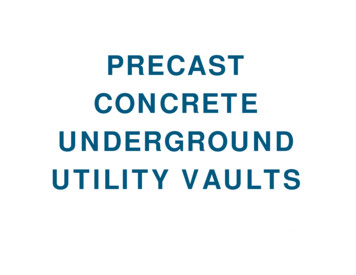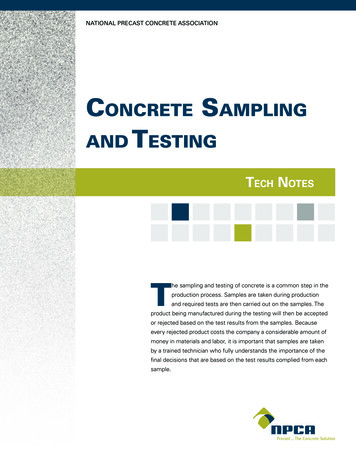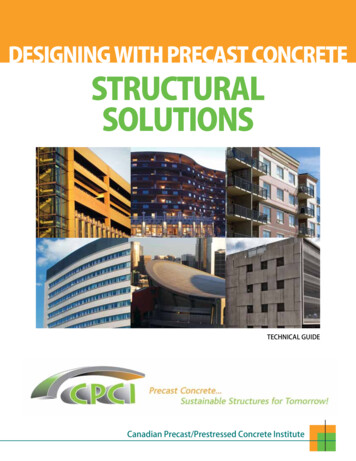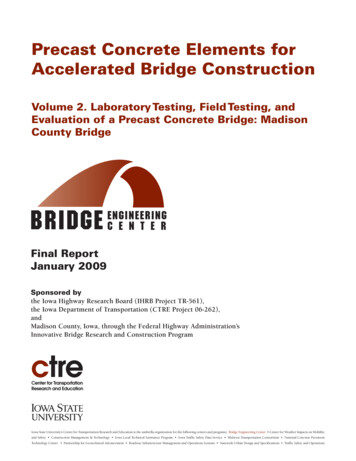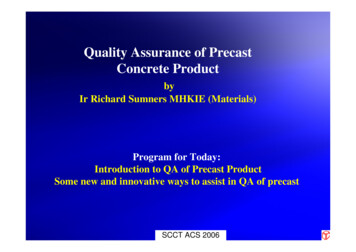
Transcription
Quality Assurance of PrecastConcrete ProductbyIr Richard Sumners MHKIE (Materials)Program for Today:Introduction to QA of Precast ProductSome new and innovative ways to assist in QA of precastSCCT ACS 2006
Definition.“ The manufacture of off-site, moulded, orformed product using a hydrauliccementitious material as a binder toconstruct a useful product or shape.”SCCT ACS 2006
Examples of Precast ProductsSCCT ACS 2006
SCCT ACS 2006
SCCT ACS 2006
SCCT ACS 2006
What are the different precast products requiring QA.Simple Answer :- AllPlant certification Classified into 4 main groupsArchitecturalBridgesCommercialGRCRefer to www.pci.org for further detailsSCCT ACS 2006
Quality SystemProduction PracticesRaw Materials and AccessoriesConcreteReinforcement and Stressing,Quality Control/ AcceptabilitySCCT ACS 2006
Quality SystemExtract from cl.4.1.1 of Code of PracticeFor Precast Concrete Construction 2003 issued by BD“A factory selected for the casting of units mustensure that the precast units are manufacturedunder a Quality Assurance Scheme certified underISO 9000 covering the following items: quality control tests of materials; calibration of laboratory equipment for qualitycontrol tests; and production process and control of equipment atthe casting yard”SCCT ACS 2006
Production Practices Safety Production and Curing Facilities Moulds ‘Hardware’ installation(e.g. anchor bolts,plates, windows, tiles,etc) Handling Surface Finishes Repairs Acceptability of Appearance Sealers/coatings Etc, etc.SCCT ACS 2006
Safety With nearly precast plants for supply to HKin Guangdong Province safety of allpersonnel is obviously a high concern. Safety is difficult to achieve given the lack ofeducation/understanding of the labourers.But precasters do try there best with theavailable resources and it is an uphill battlethat they are continually facing. To date levels of reported incidents ofserious safety issues at precast facilites islow.SCCT ACS 2006
Production and Curing Practices Suitable to ensure samples/moulds areprotected against detrimental environmentconditions.Adequate lighting for all operationsIdeally ‘maintain suitable ambienttemperature within production area’Mould Fabrication facilities (some localprecasters make there own !)a. capable of providing moulds of therequired accuracyb. Moulds stored appropriately to avoiddamage/change of dimensions e.g. due toexecessive temperaturec. Use qualified Design Engineers /SpecialistsSCCT ACS 2006
Production and Curing Practices Suitable Storage of Materials Hardware Fabrication and Storage (toavoid distortion and other affects) –External records for outside suppliers. Casting Area and Equipment Sufficient and suitable equipment. Flexibility in planning spacing of mouldsand movability of workers, materialsand product. When stressing activities performed –separate distinct/secure area. Sufficient Ventilation for certainapplications.SCCT ACS 2006
Curing AreasMost curing is by using ambient (covered inpolyethylene or wet hessian) curing conditions(Normally cured for at least 4 days) Sometimes Steam curing used to ensure oneday production cycle (or more frequent) –common practice is to control temperature( 55 /-5oC) of steam at suitable ‘agreed’locations near the surface of the element by useof thermocouples. The steam is applied 4 hoursafter pouring at a rate of 10oC per hour ensuringconcrete temperature does not exceed 70oC (e.g.Segments). When cooling same rate applies. Power regulated Heat Lamps are occasionallyused for certain applications instead of steam(e.g. curing of LVT Blocks).SCCT ACS 2006
Materials and Construction Moulds maybe made of a variety of materials. Stable to produce required finish and tolerance Some may be reused many times others maybeone-off. For reusable moulds checking ofmoulds before reuse is required Appropriate selection of mould type and quality.The appearance of finish is directly related tothe choice of mould material and quality of themould. Selection of Mould Release agent will bedependent on type of mould and possibleaffects on finish (e.g. discolouration/staining)SCCT ACS 2006
MouldsSplit, Singleor Multiple MouldsMoulds from Different Materials (Timber, GRP, GRC, Steel orRubber)SCCT ACS 2006
MouldsVerification and Maintenance Mould Surfaces and dimensions checked in detailagainst design drawings before casting. (normallydimensional/ flatness / squareness / twist/straightness / visual checks) Moulds have to be cleaned and inspected before eachuse. Inspection to look for defects/contaminationsthat may affect appearance/performance and correctassembly with design drawings. Templates(used for flatness checking etc)and other equipment used toverify moulds also have tobe inspected and maintainedregularly. Mould Release agent appliedevenly without ponding.SCCT ACS 2006
Finishing AreasDepends on the type of product, some products nofinishing treatment required prior to storage anddelivery others may require extensive treatment.For the latter case good lighting is essential atthe point where final inspection takes place.Lighting should be as close possible to the actuallighting conditions of the product when in service.Also the area shall contain all the elementsnecessary for the appropriate finish to be applied(more detail later)SCCT ACS 2006
Handling EquipmentThe type, capacity of equipment for handling finishedproducts depends on the product and its operatingconditionsEquipment maintained in good working order to beCapable of stripping, moving , stacking, retrieving ,loading units without damage.Storage Area for Finished ProductsAdequate size for safe (damage free) storage , easyaccess (required for inspection) and handling ofproducts.Area should be clean, well drained and stabilized.Storage conditions will be dependent upon product.SCCT ACS 2006
HandlingThe handling method depends on the type ofproduct Susceptibility to damage.Size / Weight of the productSuitable procedures required for eachproduct type to allow for demoulding, lifting ,storage and preparation for transport.The handling has to ensure that structuraldamage, detrimental cracking, architecturalimpairment or permanent distortion areavoided.SCCT ACS 2006
Yard Storage/Loading. Careful Planning, Units generally supported with 2-point supportsspaced at about 1/5th point. Stored on firm and level ground. Stored & Loaded in a way to protect from damage,discolouration or staining of finished product. Stored and loaded in a suitable manner to allowfor moving at later stage. Stored and loaded using even loading to preventdomino effect.Cleaning All exposed surfaces of units cleaned asnecessary prior to shipping to remove dirt, stainsetc.SCCT ACS 2006
StorageSCCT ACS 2006
Sealers or Clear Surface Coatings When Specified Precasters use sealers/clearsurface coatings after surface finishaccepted. Architectural Concrete normally do not usesealers for waterproofing. Sealers used have to be checked before useto ensure that they do not cause stains ,darken , discolour the finish or cause similareffects to any joint sealants that maybepresent.SCCT ACS 2006
Hardware InstallationAll Hardware checked prior to casting to verify Correct size and Type Sufficient Quantity Coating Accuracy. Strength. Correct Alignment/positioning.During casting hardware also checked toEnsure that they have not moved andconcrete around them consolidated correctlySCCT ACS 2006
Stripping, Lifting Tests performed to confirm that concretestrength achieves requirement forstripping, detensioning and lifting. (PrecastCode of Practice PNAP 286)SCCT ACS 2006
Stripping Tests performed to confirm that concretestrength achieves requirement for stripping,detensioning and lifting. (Precast Code ofPractice PNAP 286) All removable inserts, fastenings, mouldparts released and/or removed prior tostripping. Units uniquely identified in appropriateplace to include cast date or serialnumber. Surface of Unit checked for damageSCCT ACS 2006
Surface FinishesHow to ensuring quality of finish !.First all parties agree on the acceptabletype of finishThis is achieved by using by variouswaysSCCT ACS 2006
Surface FinishesSpecifications (e.g. Civil Eng Spec Volume 2, ParticularSpecification stating tiling requirements etc.)SCCT ACS 2006
Surface FinishInitial standard points of reference.Refer to PCI –Color Texture Guide athttp://www.pci.orgSCCT ACS 2006
Surface FinishesMock-up/Control sampleswith varying levels of colour/acid etching/ tooling etcDo Not use one sample ascontrol use a series or range !.SCCT ACS 2006
Painted FinishesSCCT ACS 2006
Acceptability of Appearance Agreement on how to accept finish (lightingrequirements / colour (range) requirement/ intensity ofshade requirements / depth of etching etc ) Generally Subjective individual judgment. StandardRules therefore difficult. “Finish face surface shall have no obviousimperfections other than minimal colour and texturevariations from the approved samples or evidence ofrepair when viewed in good typical daylight illuminationwith the unaided naked eye at 6m viewing distance.” Colour variation will vary greatly with different colours ,e.g. white will have minimal variation whereassomething such as dark blue is difficult to control. Also Note ensure persons assessing and / or acceptingdo not suffer from colour deficiencySCCT ACS 2006
Repairs A certain amount of Repair Should Alwaysbe expected. Repair normally requires a lot of care andshould always be performed by experts. Selection of the appropriate repair materialto ensure that the end-product may bestructurally sound , durable or visuallyacceptable and all of these not impaired bythe repair. Excessive variation in colour or texture ofrepairs from the surrounding surfaces mayresult in the panels being not approveduntil the variation is minimized.SCCT ACS 2006
Repairs Repairs should be done prior to beingplaced in the storage area. Colour variations between new and oldsamples will always be evident. Repairsdifferences will blend in time (severalweeks). Earlier repair made normally thebetter. If Substantial variation in colour and textureof repairs from the surrounding area occur,the repair may be required to be removedand new repair material installed. Small cracks ( 0.25mm) may not needrepair unless failure to do can causecorrosion of reinforcement.SCCT ACS 2006
RepairsHow are common repairs normally performed. Filling Cracks with epoxy Filling imperfections (blow holes, water holes,exposed aggregate , bleed scarring etc) withcement sand (or CRF) mortar / brush or rub intoplace with latex or similar material as gaugingmedium. Care required as may cause colourvariations More Acid Etching/sandblasting (make it lighter) Removal of stains (removal depends on type ofstain) Blending pigment slurry into the repair area. Breaking out and Reinstatement. Many othersSCCT ACS 2006
Raw Materials and Accessories* Concrete Materials(Concrete Materials Comply to the requirements of HKQAA QSPSC(or equivalent) plus any other additional Specification requirements)* Reinforcement and Hardware(Comply to the requirements of CS2 / BS 5896 / BS4482/ BS4483and/or other additional Specification requirements)* Others(Window frames, Tiles, Insulations, Conduits for E & M Fixings,lighting, TV ., Waterproofing, Welding for Hardware Etc.) Precasters arrange testing to be performed of the materialsat HOKLAS accredited labs (or equivalent) if available priorto use and acceptance.SCCT ACS 2006
Raw Materials Others– Window frames– Tiles– Insulations– Conduits for E & M Fixings, lighting,TV .– Waterproofing– Welding for Hardware– Etc.SCCT ACS 2006
Concrete Concrete Comply to HKQAA QSPSC (or equivalent) Coloured Concrete comply to QSPSC (or equivalent) Glass Fibre Reinforced Concretecomply to ISO 9001 & BS EN1169Reinforcement and Stressing, Storage Installation Tensioning Pre-tensioning Post tensioningSCCT ACS 2006
Quality Control/ Acceptability Inspection Testing Records Laboratory AnalysisSCCT ACS 2006
Inspection (Internal and/or External) External Inspections HKIAS HKHA Q-Plus PCI Internal Pre and Post pour Inspections. Inspections have to managed in an efficient mannerso as not to cause downtime for production/deliveryand yet ensure that the product meets all setrequirements. Number/Qualification of persons performinginspection directly related to complexity of product andnumber of samples Scope of InspectionSCCT ACS 2006
Scope of Inspection Plant testing of materials for acceptance prior to initialplacement and daily check testing for maintenance Mix Design and routine concrete testing. Inspection of Moulds (moulds for tightness, flatness,squareness, dimensions , condition etc) and new set-upchanges prior to pouring. Checking of quantity/location/positioning of cast-in items,reinforcement and other critical items. Inspection of batching, mixing , placement, compaction,curing and finishing Inspection of demoulding, product identification (castnumber/cast date/job number), condition, etc.SCCT ACS 2006
Scope of Inspection General observations of plant, equipment, workingconditions and other items that may affect production. Preparation of specimens for lab tests Inspection of finish Check finished product against drawings/approvedsamples Inspection of storage, checking method of storage ,contamination , conditions etc. Final Inspection of product during loading for properblocking, detection of stains, cracks and other defects. Inspection of product following repair.SCCT ACS 2006
SCCT ACS 2006
Quality Control/ AcceptabilityTesting Internal Plant Quality Control Monitoring. Product Approval (normally HOKLASendorsable report) Ideally Testing performed at the precastfacilitya) eliminate delays in production,b)
(Window frames, Tiles, Insulations, Conduits for E & M Fixings, lighting, TV ., Waterproofing, Welding for Hardware Etc.) Precasters arrange testing to be
